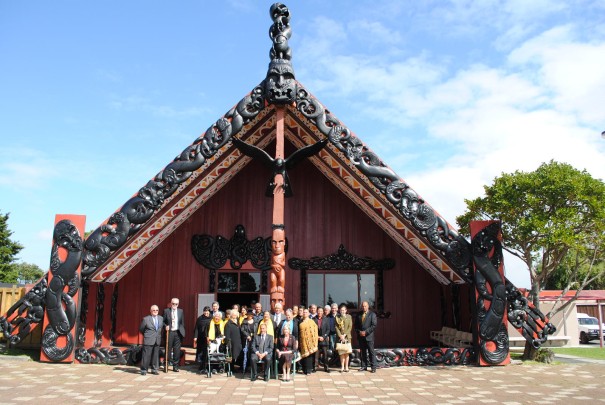Welcome on to Ōrākei Marae

To view more images, click here
E nga Rangatira o Ngāti Whātua o Ōrākei, Grant Hawke, Joe Hawke. Tēnā koutou mo te pōwhiri ki tēnei Marae. Kia ora huihui tatou katoa.
Distinguished guests, Rangatira and Kaumātua of Ngāti Whātua o Ōrākei, especially Grant and Joe Hawke, and members of Ōrākei Marae, ladies and gentlemen, thank you for your welcome.
I also acknowledge the greetings you have extended as I join you as representative of Queen Elizabeth, the Queen of New Zealand. I receive your welcome and share your sentiment of good health to all who are gathered here.
Thank you for receiving me and my wife Janine onto Ōrākei Marae this morning. This is a special day for me. It is my first visit to this marae, and this first visit I arrive as te Mangai a Kuini Irihapeti.
My heritage is of Te Arawa waka, and specifically Ngāti Tūwharetoa. I am also descended from Tākitimu waka and Ngāti Kahungunu. My mother’s mother had close links to Tūhoe. However, I am also a descendent of immigrants who arrived at Petone on the sailing ship, Katherine Stewart Forbes, under the command of Captain Peter Elder, in 1841 .
Ngāti Whātua o Ōrākei stands at the confluence of several streams in the history of New Zealand. I stand before you today to acknowledge your mana, and also your heritage as it relates to my role as the Governor General of New Zealand.
The story of Ngāti Whātua o Ōrākei represents the loyalty and trust that many iwi placed in the Treaty of Waitangi—Te Tiriti o Waitangi and in the protection offered by the Crown. You were one of the first tribes outside of Northland to sign the Treaty, less than two months after it was signed at Waitangi Day on 6 February 1840.
The story of Ngāti Whātua o Ōrākei also represents the establishment of the city of Auckland. Āpihai Te Kawau signed the Treaty and invited my predecessor William Hobson to move New Zealand’s capital here. Te Kawau and his people willingly sold 3000 acres to the Crown for the new town.
The story of Ngāti Whātua o Ōrākei also represents the failure of the Crown to meet its obligations under the Treaty. That initial 3000 acres was acquired for £341 and yet six months later, just 44 acres was resold by the Government for £24,275. In effect, the early development of Auckland was paid for by profits of this sale.
By the 1950s, through a series of actions by the Crown, including the work of the Native Land Court, Ngāti Whātua o Ōrākei was virtually landless. The remaining village at Ōkahu Bay was destroyed in the early 1950s, the residents evicted, their houses demolished and their meeting house burned to the ground. It was a tragic time, for Ngāti Whātua and more widely, for New Zealand.
The story of Ngāti Whātua o Ōrākei represents resistance to the loss of land. Ngāti Whātua has been at the forefront of action over the loss of its tribal land since 1881, when Paora Tūhaere hosted a pan-national assembly of chiefs at Kohimarama.
And when, a century later, the Crown sought to subdivide and sell the last remaining part of the Ōrākei Block, Joe Hawke led a 506-day occupation of Bastion Point. The images of protesters, being arrested and evicted from their ancestral lands were shocking, compelling and evocative.
So the story of Ngāti Whātua o Ōrākei also represents the turning of the tide of relations between iwi and the Crown. Media coverage of Bastion Point — like Dame Whina Cooper’s hikoi in 1975 — raised awareness among New Zealanders of past breaches of the Treaty and Māori grievances over land issues. Within a short time, the jurisdiction of the Waitangi Tribunal was retrospectic to 1840 and the Crown began settling historic claims in good faith.
The process of negotiations by the Crown aims to achieve genuine acknowledgement and reconciliation, to resolve grievances and build comprehensive and durable settlements.
Ngāti Whātua o Ōrākei campaigned for justice and its claim regarding the Ōrākei Block was rightly resolved in the Ōrākei Act 1991. I welcome Parliament’s consideration of the Ngāti Whātua Ōrākei Claims Settlement Bill which builds on that earlier work for the final settlement of your historical claims.
The story of Ngāti Whātua o Ōrākei represents leadership. Beginning with Āpihai Te Kawau, it has continued to this day. It includes the outstanding leadership of the late Professor Sir Hugh Kāwharu. Ta Hugh was a great scholar, a great advocate for his people, and a great New Zealander. My predecessor Dame Silvia Cartwright invested him with New Zealand’s highest honour, the Order of New Zealand, here at Ōrākei Marae in 2002 . The fine tradition of leadership he represented continues today.
Finally, the story of Ngāti Whātua o Ōrākei represents hope: a better future for your tamariki and mokopuna, for this iwi and for all New Zealanders.
As a loyal iwi that worked diligently to build a strong relationship with the Crown Ngāti Whātua o Ōrākei were marginalised, dispossessed and rendered virtually landless. Through impressive leadership and manaakitanga Ngāti Whātua o Ōrākei are once again poised to play a prominent role in the social, cultural, economic and political life of Auckland— Tāmaki Makaurau. It is the role that Āpihai Te Kawau would have sought for Ngāti Whātua when he signed the Treaty 172 years ago.
It has taken a long time, but your persistence, commitment to justice and goodwill is being recognised. And with that you are setting the conditions of hope; the passing of mana from one generation to the next. No reira, huri noa ki a tatou e huihui nei, mauri ora ki a tatou katoa.
